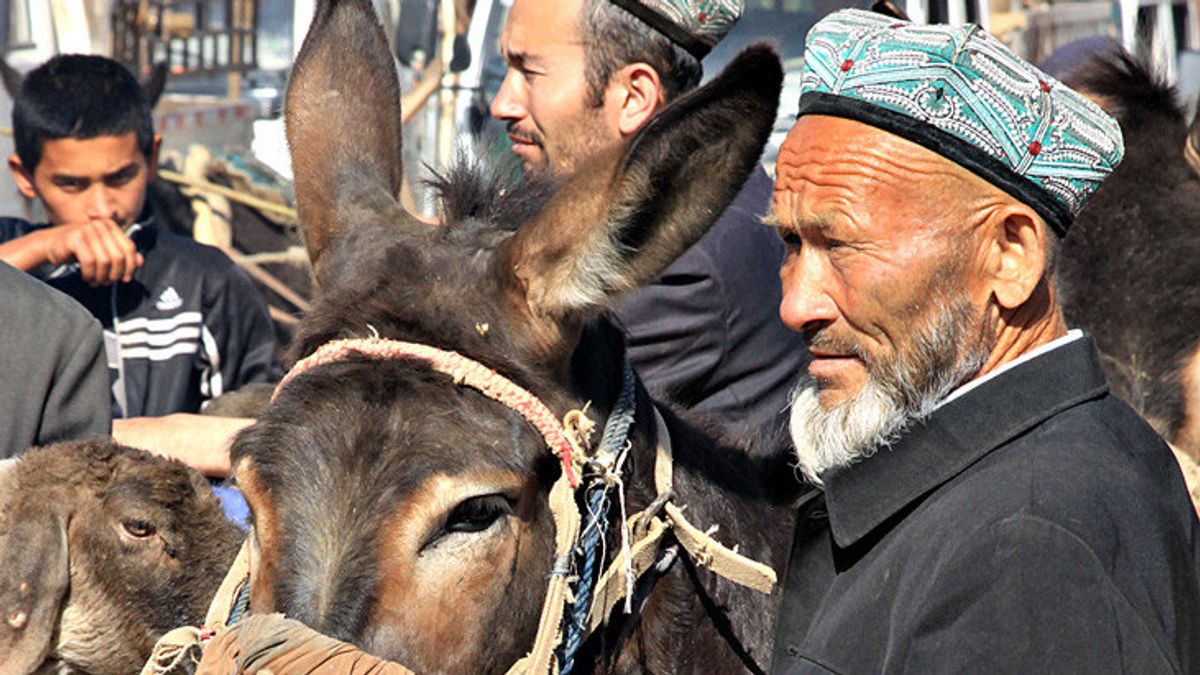JAKARTA - A decade ago, making pilgrimages to religious sites was commonplace for the Uighur Muslim community in western China. At that time, pilgrims could travel freely, including visiting the Imam Asim site which was the main destination for many pilgrims. However, conditions today were different. China has now destroyed many vital Uighur Muslim sites, including a number of mosques.
Imam Asim is a great scholar who has been respected by Uighur Muslims from generation to generation. Imam Asim is a figure who overthrew the long-ruling Buddhist kingdom in the area. Reported by The New York Times , Friday, September 25, followers of Imam Asim are still loyal to attend the annual festival to worship the Ulama.
The festival is usually used by followers to pray for various purposes, from harvest, sustenance, to health. There are a number of rituals that are commonly performed in festivals. One of them is carrying a prayer message to a wooden pole around the Imam Asim holy site. In addition, pilgrims can also enjoy various entertainment around the holy site, such as magic, wrestling, hearing storytellers, and listening to the music that is presented.
"It's not just a pilgrimage. There are players, games, food, poetry readings, and entire areas for storytelling. It's still full of people, and full of life, ”said Tamar Mayer, a professor at Middlebury College, who made visits to the Imam Asim holy site for research in 2008 and 2009.
Massive destruction
Now, the culture of the pilgrimage that has been going on for a long time is starting to be restricted. The fence and wooden posts surrounding Imam Asim's grave were torn down. This condition can be seen from satellite images that show a mosque that has been leveled to the ground. Referring to this satellite image, the tomb of Imam Asim now only appears as a rock and mud structure.
More sadly, China has reportedly also destroyed other Uighur Muslim holy sites, including a number of mosques in Xinjiang. On a broader scale, since 2014 Chinese authorities have even banned Uighur Muslims from performing the pilgrimage. The massive destruction increases sentiment towards the Chinese Government.
The massive destruction was carried out by China as part of an effort to urge Uighurs, Kazakhs and members of other Central Asian ethnic groups to join the Communist Party. In fact, in that effort the Chinese Government also reportedly detained hundreds of thousands of people.
Quoted from a recent report by the Australian Strategic Policy Institute, they systematically exposed the level of damage and change to religious sites in recent years in Xinjiang. They noted an estimate that around 8,500 mosques across Xinjiang have been razed since 2017.
"What he presented was a campaign of destruction and eradication unprecedented since the Cultural Revolution," said one of the researchers, Nathan Ruser.
Nathan added that this was not new to China. Since under Mao Zedong's leadership, China has destroyed many mosques and religious sites. Their data shows there are at least 533 mosque sites across Xinjiang - calculated using a random sample - that China has destroyed. The researchers also used satellite images to assess changes.
China's rebuttal
The Chinese government has dismissed reports of widespread destruction and demolition of religious sites. They called the issue nonsense. The Chinese government has even assured the public that they uphold the protection and repair of mosques and other Muslim sites.
A Chinese official has accused the Australian Strategic Policy Institute of defaming his country. They said the role of the United States (US) as a contributor to funding for the research institute had influenced the published reports. The Australian Strategic Policy Institute denies that charge.
The institute even reminded the public about the steps taken by the Chinese government to impose strict controls on Xinjiang. This strict control includes restrictions on the flow of information to and from the region. The condition was said by the Australian Strategic Policy Institute as a challenge they had to face.
The New York Times also verified data related to the Australian Strategic Policy Institute's report. Satellite image analyzed. They also tried to verify the report by compiling information from people who had visited South Xinjiang in the last year.
"What we're seeing here is the deliberate destruction of sites that are in all respects the legacy of the Uighurs and the legacy of this land," said Rachel Harris, an expert on Uighur music and culture at the University of London, who reviewed the report.


According to him, many holy sites and cemeteries that have recently been closed and destroyed are holy sites for Uighur Muslims. In his view, Uighurs often make pilgrimages to religious sites complete with food offerings as a form of their piety. In fact, the ritual can take weeks, during which they will travel from one sacred site to another.
Another holy site mentioned is the holy site of Ordam. The holy site, which has been on pilgrimage for 400 years, is believed by Uighurs to be the tomb of a leader who brought Islam to the region.
"If you had a donkey and a cart, you would fill your food and spend three weeks going to the holy site. The only place I see an adult Uighur man crying is at a holy site," said a researcher at the University of Nottingham who has studied Ordam, Rian Thum.
Not a new incident
Return to massive destruction as nothing new. It is said that restrictions on religious activities have mushroomed since the 1990s. Since then the Chinese government has been nervous about the expansion of mosques and the resurgence of many holy sites in Xinjiang. Local officials think it will ignite fanaticism and unbridled extremism.
Shortly thereafter, local authorities began banning festivals and pilgrimages to Ordam and other holy places in 1997. Even so, the Uigur's enthusiasm for the figure he worshiped kept them coming to the holy site.
“One Uighur who managed to visit Ordam told some of the nearby villagers that he had visited. And they started crying and another one asked for some dust from his jacket. It gives the impression of how important this place is to people, even when they can't visit, ”added Thum.
In the future, the Chinese government will further tighten the ban on visits to the holy site of Ordam. As a result, in early 2018, the site was razed to the ground. In the sense that the owner of the policy has removed the most important sites of Uighur heritage.
Based on satellite images, the mosque, prayer room and modest housing where the guards of the holy site live have been destroyed. "You are seeing real and what appears to be a conscious effort to destroy places that are important to Uighurs, precisely because they are important to Uighurs," said Thum.
In several cases, the Chinese government said the destruction of mosques was carried out for development purposes. To see the traces of destruction, Times reporters visited Hotan City in southern Xinjiang last year. He found that the mosque that was visible on the satellite was still standing in 2017, when it was leveled to the ground.
The journalist also found that four other sites in the form of a mosque that once stood had been converted into parks or just an empty plot of land. Even so, the main mosque in Hotan remains. However, because of fear, many people do not dare to go to the mosque directly. Even if it's for Friday prayers.
Not much different from Hotan City, Kashgar which is a large city in southern Xinjiang, too. Almost all mosques have been closed. In fact, there is one mosque that has been turned into a bar. “It's like I lost family members around me because our culture was taken away. It is like part of our flesh, our bodies are being thrown away, ”said a Uighur graduate student from Kashgar, Mamutjan Abdurehim.
However, not all religious sites were destroyed. Some have become official tourist attractions, even though their status no longer functions as pilgrimage sites. The Afaq Khoja Mausoleum and Kashgar's famous Uighur cemetery appear to have survived. "The intensity of this crackdown is quite surprising. Many Uighurs who want to hope are quite pessimistic, including me," concluded Abdurehim.
The English, Chinese, Japanese, Arabic, and French versions are automatically generated by the AI. So there may still be inaccuracies in translating, please always see Indonesian as our main language. (system supported by DigitalSiber.id)













